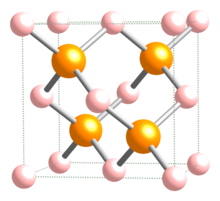
| |
| Identifiers | |
|---|---|
3D model (JSmol)
|
|
| ChemSpider | |
| ECHA InfoCard | 100.041.126 |
| EC Number |
|
PubChem CID
|
|
CompTox Dashboard (EPA)
|
|
| |
| |
| Properties | |
| AlAs | |
| Molar mass | 101.9031 g/mol |
| Appearance | orange crystals |
| Density | 3.72 g/cm3 |
| Melting point | 1,740 °C (3,160 °F; 2,010 K) |
| reacts | |
| Solubility | reacts in ethanol |
| Band gap | 2.17 eV (indirect)[1] |
| Electron mobility | 200 cm2/(V·s) (300 K) |
| Thermal conductivity | 0.9 W/(cm·K) (300 K) |
Refractive index (nD)
|
3 (infrared) |
| Structure | |
| Zinc Blende | |
| T2d-F-43m | |
a = 566.0 pm
| |
| Tetrahedral | |
| Thermochemistry | |
Std molar
entropy (S⦵298) |
60.3 J/mol K |
Std enthalpy of
formation (ΔfH⦵298) |
-116.3 kJ/mol |
| Hazards | |
| NIOSH (US health exposure limits): | |
PEL (Permissible)
|
[1910.1018] TWA 0.010 mg/m3[2] |
REL (Recommended)
|
Ca C 0.002 mg/m3 [15-minute][2] |
IDLH (Immediate danger)
|
Ca [5 mg/m3 (as As)][2] |
| Related compounds | |
Related semiconductor materials
|
Aluminium gallium arsenide, Aluminium indium arsenide, Aluminium antimonide, Boron arsenide |
Except where otherwise noted, data are given for materials in their standard state (at 25 °C [77 °F], 100 kPa).
| |
Aluminium arsenide (AlAs) is a semiconductor material with almost the same lattice constant as gallium arsenide and aluminium gallium arsenide and wider band gap than gallium arsenide. (AlAs) can form a superlattice with gallium arsenide (GaAs) which results in its semiconductor properties.[3] Because GaAs and AlAs have almost the same lattice constant, the layers have very little induced strain, which allows them to be grown almost arbitrarily thick. This allows for extremely high performance high electron mobility, HEMT transistors, and other quantum well devices.[4][page needed]
- ^ "AlxGa1−xAs". Ioffe Database. Sankt-Peterburg: FTI im. A. F. Ioffe, RAN.
- ^ a b c NIOSH Pocket Guide to Chemical Hazards. "#0038". National Institute for Occupational Safety and Health (NIOSH).
- ^ Guo, L. "Structural, Energetic, and Electronic Properties of Hydrogenated Aluminum Arsenide Clusters". Journal of Nanoparticle Research. Vol. 13 Issue 5 p. 2029-2039. 2011.
- ^ S. Adachi, GaAs and Related Materials: Bulk Semiconducting and Superlattice Properties. (World Scientific, Singapore, 1994)